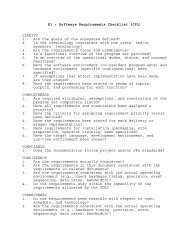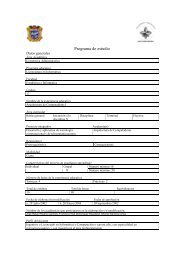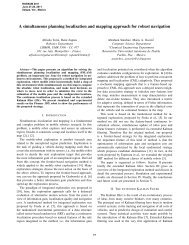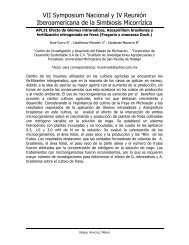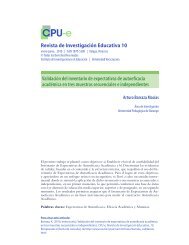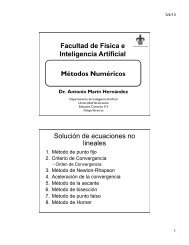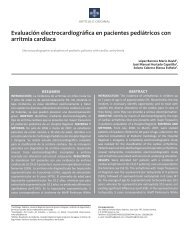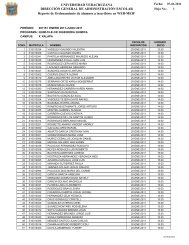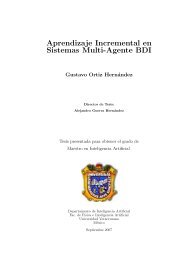Understanding the Software Options
Understanding the Software Options
Understanding the Software Options
You also want an ePaper? Increase the reach of your titles
YUMPU automatically turns print PDFs into web optimized ePapers that Google loves.
PLANT OPERATION STAGE – SOME IDEAS ON HOW TO BE GREEN<br />
• Consistently operate <strong>the</strong> plant within optimum parameters. This<br />
may sound obvious but it is quite important from <strong>the</strong> profitability<br />
and environmental viewpoints and not always an easy task<br />
• Continuously look for opportunities to obtain competitive advantages<br />
in terms of higher yields, reduced waste, lower temperatures,<br />
reduced reliance on dangerous raw materials or<br />
intermediates, reduced energy, reduced utilities consumption<br />
and so on<br />
• Always consider opportunities to reduce, reuse and recycle. For<br />
example reduce raw materials consumption and waste, reuse<br />
or recycle off-specification products. If reuse or recycle is not<br />
practical, consider treating any off-specification products to a<br />
lower-value material instead of sending it to waste treatment<br />
• Take steps to prevent waste formation instead of relying on waste<br />
treatment<br />
• Find uses for byproducts<br />
• Think outside of <strong>the</strong> box and challenge <strong>the</strong> traditional “that is<br />
how we have done it for 20 years” mentality<br />
• Develop and implement relevant metrics, such as emissions and<br />
Btu (or Kcal) per ton of product<br />
• Build a culture in which safety and environmental stewardship<br />
are top priorities and create stretch goals such as zero personal<br />
injuries, zero accidents and zero process safety incidents<br />
chemical engineering skills is required<br />
to achieve demonstrable results. The<br />
box above presents some specific<br />
ideas on how to be greener during<br />
operations.<br />
The energy case as an example<br />
Energy consumption is especially<br />
relevant to this discussion considering<br />
that: a) <strong>the</strong> world’s energy requirements<br />
are expected to double by<br />
2050, b) fuel-related expenditures (in<br />
terms of both energy production and<br />
raw materials) represent a major cost<br />
incurred by <strong>the</strong> CPI, and <strong>the</strong> use of<br />
fossil fuels is also implicated in <strong>the</strong><br />
production of greenhouse gas emissions<br />
(GHG).<br />
The American Chemistry Council<br />
website (ACC; americanchemistry.<br />
com) provides very interesting data<br />
on <strong>the</strong> significant improvements that<br />
have been achieved by <strong>the</strong> chemical<br />
industry in terms of its reduced energy<br />
consumption. Considering that energy<br />
has a huge impact on <strong>the</strong> production<br />
costs in <strong>the</strong> CPI, it becomes quite clear<br />
that to be competitive and profitable<br />
<strong>the</strong> CPI need to find and implement<br />
mechanisms to reduce <strong>the</strong>ir energy<br />
consumption and become greener.<br />
Defining clear metrics, such as energy<br />
per unit of output, and setting<br />
concrete goals, are key to achieving<br />
continuous improvement. O<strong>the</strong>r metrics,<br />
such as GHG emissions per ton of<br />
product, help to evaluate <strong>the</strong> potential<br />
impact of <strong>the</strong> operation on <strong>the</strong> planet<br />
and to identify <strong>the</strong> best opportunities<br />
for improvement.<br />
44 CHEMICAL ENGINEERING WWW.CHE.COM AUGUST 2011<br />
More advanced metrics used by <strong>the</strong><br />
ACC and explained on its website<br />
include <strong>the</strong> ratio of GHG savings to<br />
GHG emissions. This ratio compares<br />
“pros and cons” of a particular product<br />
in terms of GHG emissions. For<br />
example, if <strong>the</strong> production of a certain<br />
piece of insulation foam involves<br />
<strong>the</strong> generation of 1 lb CO 2 but during<br />
its useful life <strong>the</strong> same piece of foam<br />
avoids heat losses and saves enough<br />
energy to avoid <strong>the</strong> generation of 233<br />
lb of CO 2 , <strong>the</strong>n <strong>the</strong> ratio for this building<br />
insulation foam is 233:1. O<strong>the</strong>r<br />
examples are glass and carbon fiber<br />
for wind turbines (ratio 123:1) and<br />
so on. These advanced metrics help<br />
not only to illustrate <strong>the</strong> tremendous<br />
benefits of <strong>the</strong> CPI to society but also<br />
to identify <strong>the</strong> best opportunities for<br />
doing so.<br />
However, while metrics are very<br />
important, <strong>the</strong>y are not enough to get<br />
dramatic improvements. Meeting objectives<br />
related to environmental sustainability<br />
requires innovation and <strong>the</strong><br />
appropriate use of technology, <strong>the</strong> application<br />
of proper engineering skills<br />
and a commitment from <strong>the</strong> entire organization<br />
(including upper management).<br />
It also requires <strong>the</strong> establishment<br />
of clear goals and objectives, and<br />
<strong>the</strong> development of a properly designed<br />
and managed energy-saving program<br />
that includes education, measurement,<br />
follow-up and recognition.<br />
Green practices are inherent to <strong>the</strong><br />
chemical engineering profession and<br />
promoting and implementing <strong>the</strong>m<br />
is <strong>the</strong> responsibility not just of upper<br />
• Measure, track and minimize emissions of GHGs, volatile organic<br />
compounds and regulated substances<br />
• Minimize inventories of raw materials, intermediates and final<br />
products to minimize risks, costs and emissions<br />
• Fully understand risks and previous accidents associated with <strong>the</strong><br />
technology at hand, and operate accordingly<br />
• When downsizing, make sure that <strong>the</strong> remaining employees<br />
have adequate knowledge of <strong>the</strong> technology, <strong>the</strong> processes and<br />
understand how to reduce risk and emissions<br />
• Properly maintain insulation to support greater energy efficiency<br />
• Repair steam and utility leaks [4] and replace deficient<br />
steam traps<br />
• Change disposable filters as needed to avoid unnecessary and<br />
costly pressure drop<br />
• Properly maintain flowmeters so that no waste or inefficiencies<br />
are created as a result of improper flowrates<br />
• Optimize fuel gas to flares and furnaces<br />
• Look for opportunities to reuse water<br />
• Measure and minimize chemical oxygen demand of wastewater<br />
• Optimize compressed-air systems to minimize energy<br />
consumption [7]<br />
• Use local materials (fo raw materials and spare parts) to minimize<br />
<strong>the</strong> environmental impact due to excessive transportation ❏<br />
management but of all chemical engineering<br />
practitioners, regardless of<br />
function. With <strong>the</strong> demand for continuous<br />
improvement coming from society<br />
and all industry stakeholders, green<br />
chemical engineering offers magnificent<br />
challenges and extraordinary opportunities<br />
to innovative engineers. n<br />
Edited by Suzanne Shelley<br />
References<br />
1. Nair, Sukumaran, What are <strong>the</strong> strategies<br />
for sustainable chemical production?, Hydrocarbon<br />
Proc., Jan. 2011, pp. 69–77.<br />
2. Esty, Daniel C., and Andrew S. Winston,<br />
“Green to Gold”, John Wiley and Sons, 2009.<br />
3. Carbon Dioxide Gets Boost as Feedstock,<br />
Chem. Proc., Aug. 2010, pp. 12–13.<br />
4. Ottewell, Sean, Sustainability Sustains its<br />
Appeal, Chem. Proc., Nov. 2009, pp. 21–24.<br />
5. Ottewell, Sean, A Different Plant Appears<br />
on <strong>the</strong> Horizon, Chem. Proc., Aug. 2009, pp.<br />
14–18.<br />
6. Hall, Nina et al, “The New Chemistry,” Cambridge<br />
University Press, 2000.<br />
7. Bravo, Fabio, o<strong>the</strong>rs, Wisely Use Emergency<br />
Scrubbers with Vent Systems, Chem. Eng.<br />
Prog., Aug. 1997, pp. 62–68.<br />
8. Last, Tim, Cut <strong>the</strong> Cost of Compressed Air,<br />
Chem. Proc., Oct. 2009, pp. 23–26.<br />
Authors<br />
C. Delia Contreras (Phone: 281-332-8141;<br />
Email: coreytito@hotmail.com) has more than 22<br />
years of experience in <strong>the</strong> chemical, petrochemical,<br />
refining and polymer industries, including<br />
plant design and plant management. The coauthor<br />
of several published articles, Contreras<br />
holds a B.S.Ch.E. from <strong>the</strong> Universidad Industrial<br />
de Santander (Colombia).<br />
Fabio Bravo (Phone: 832-425-0889; Email:<br />
coreytito@hotmail.com) has over 27 years of experience<br />
in <strong>the</strong> chemical, petrochemical, refining<br />
and polymer industries in diverse functions<br />
mainly in plant design and project execution.<br />
He is <strong>the</strong> co-author of several published articles,<br />
and holds a B.S.Ch.E. from <strong>the</strong> Universidad Pontificia<br />
Bolivariana (Colombia) and an M.S.Ch.E.<br />
from Rice University.



